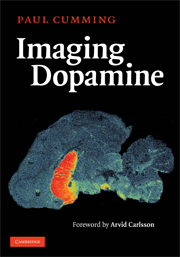Book contents
- Frontmatter
- Contents
- Foreword
- Acknowledgments
- Introduction
- 1 The life history of dopamine
- 2 Enzymology of tyrosine hydroxylase
- 3 The assay of tyrosine hydroxylase
- 4 Enzymology of aromatic amino acid decarboxylase
- 5 PET studies of DOPA utilization
- 6 Conjugation and sulfonation of dopamine and its metabolites
- 7 Dopamine synthesis and metabolism rates
- 8 MAO activity in the brain
- 9 Vesicular storage of dopamine
- 10 Dopamine release: from vesicles to behavior
- 11 The plasma membrane dopamine transporter
- 12 Dopamine receptors
- 13 Imaging dopamine D1 receptors
- 14 Imaging dopamine D2 receptors
- 15 Factors influencing D2 binding in living brain
- 16 The absolute abundance of dopamine receptors in the brain
- 17 Conclusions and perspectives
- References
- Index
- Plate section
9 - Vesicular storage of dopamine
Published online by Cambridge University Press: 04 December 2009
- Frontmatter
- Contents
- Foreword
- Acknowledgments
- Introduction
- 1 The life history of dopamine
- 2 Enzymology of tyrosine hydroxylase
- 3 The assay of tyrosine hydroxylase
- 4 Enzymology of aromatic amino acid decarboxylase
- 5 PET studies of DOPA utilization
- 6 Conjugation and sulfonation of dopamine and its metabolites
- 7 Dopamine synthesis and metabolism rates
- 8 MAO activity in the brain
- 9 Vesicular storage of dopamine
- 10 Dopamine release: from vesicles to behavior
- 11 The plasma membrane dopamine transporter
- 12 Dopamine receptors
- 13 Imaging dopamine D1 receptors
- 14 Imaging dopamine D2 receptors
- 15 Factors influencing D2 binding in living brain
- 16 The absolute abundance of dopamine receptors in the brain
- 17 Conclusions and perspectives
- References
- Index
- Plate section
Summary
Biochemistry of vesicular monoamine transporters
Two vesicular monoamine transporters of adrenal chromaffin cells (VMAT1) and catecholamine neurons (VMAT2) belong to a family of vaculolar-type proton-ATPase proteins, which are related to the bacterial antibiotic resistance transporters. Both vesicular monoamine transporters accumulate monoamines within vesicles, employing an intrinsic ATPase activity to generate the proton gradient that establishes and maintains the accumulation of monoamine substrates; in a sense, vesicles behave as inside-out mitochondria. The genetic sequence for VMAT1 was isolated on the basis of its ability to and impart resistance to MPP+, the neurotoxic metabolite of MPTP (Liu et al. 1992), apparently by sequestering the toxic metabolite out of harm's way. Indeed, the reserpine-sensitive uptake of MPP+ by chromaffin and brain synaptic vesicles could produce 100-fold concentration gradients in the presence of ATP (Moriyama, Amakatsu, & Futai 1993).
Around the same time as the cloning of VMAT1, a sequence encoding VMAT2 was cloned from the human cDNA library on the basis of its ability to impart serotonin uptake to organelles in permeabilized cells (Erickson, Eiden, & Hoffman 1992). The sequence of the VMAT2 gene predicts a 512 amino acid protein with 12α-helical membrane spanning domains, both termini and several potential phosphorylation sites being present on the cytoplasmic side. In situ hybridization signal for VMAT2 is present in the dopamine, serotonin, noradrenaline, and adrenaline neurons of the brain, all of which biogenic amines are good substrates for vesicular uptake.
- Type
- Chapter
- Information
- Imaging Dopamine , pp. 111 - 121Publisher: Cambridge University PressPrint publication year: 2009



